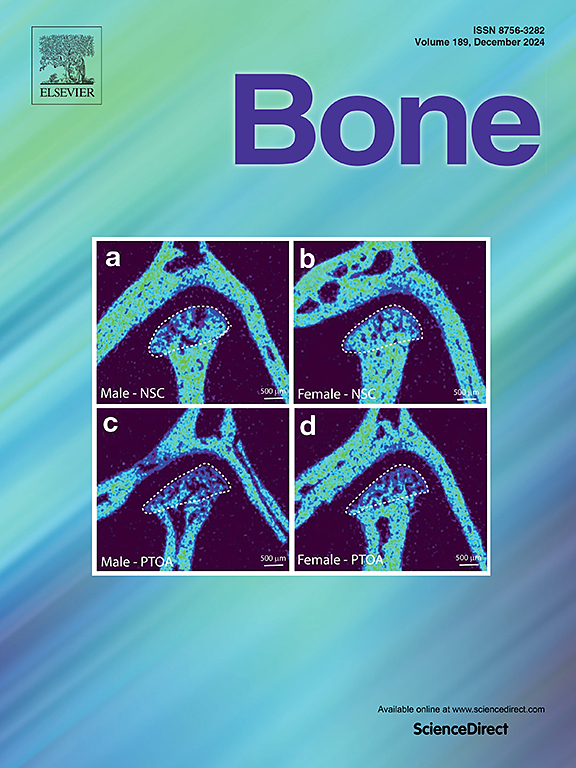腰肌收缩量减少是髋部骨折的风险因素吗?使用精确匹配技术对髋部骨折患者和非髋部骨折患者进行的比较研究。
IF 3.5
2区 医学
Q2 ENDOCRINOLOGY & METABOLISM
引用次数: 0
摘要
简介肌肉疏松症与跌倒和髋部骨折风险增加有关。然而,研究往往忽略了对年龄、性别、骨质密度(BMD)和体重指数(BMI)的全面控制。我们的研究旨在确定通过评估腰肌体积确定的肌肉疏松症是否是髋部骨折的独立风险因素。我们采用的方法包括精确匹配技术:在这项横断面比较研究中,我们将 2015 年至 2021 年期间发生髋部骨折的患者数据与来自单一中心健康检查中心的对照组数据进行了比较。研究包括 545 名髋部骨折患者和 1292 名无骨折患者。我们收集了人口统计学数据、使用双能 X 射线吸收测量法测定的 BMD,以及用于腰肌体积分析的腹部和骨盆计算机断层扫描(APCT)数据:结果:对 266 对数据进行精确配对分析后发现,腰肌体积/身高2 是所评估指标中最重要和最主要的风险因素。在对年龄、性别、体重指数和 BMD 进行调整后,多变量逻辑回归分析发现身高或经身高调整的腰肌体积是髋部骨折的独立风险因素(分别为 p = 0.042 和 p = 0.002)。年龄、女性性别、较低体重指数和较低骨密度与髋部骨折风险增加有关:结论:根据患者身高调整腰肌体积后,腰肌体积减少可独立预测髋部骨折风险。通过 APCT 评估腰肌体积是识别高危人群的实用工具,强调了将肌肉疏松症纳入髋部骨折风险评估的必要性。本文章由计算机程序翻译,如有差异,请以英文原文为准。
Is decreased psoas volume a risk factor for hip fracture? A comparative study of patients with and without hip fractures using the exact matching technique
Introduction
Sarcopenia is linked to increased fall and hip fracture risk. However, studies often overlook comprehensively controlling for age, sex, bone mineral density (BMD), and body mass index (BMI). Our study aimed to determine if sarcopenia, determined by evaluating the psoas muscle volume, is an independent risk factor for hip fractures. We employed a methodological approach that includes the exact matching technique.
Methods
In this cross-sectional comparative study, we compared the data of patients who sustained hip fractures between 2015 and 2021 with those of a control group from a health screening center in a single center. The study included 545 patients with hip fractures and 1292 without fractures. We collected data on demographics, BMD determined using dual-energy X-ray absorptiometry, and abdominal and pelvic computed tomography (APCT) scans for psoas muscle volume analysis.
Results
The analysis after exact matching of 266 pairs revealed that psoas volume/height2 was the most significant and dominant risk factor among the evaluated indices. Multivariate logistic regression analysis, adjusting for age, sex, BMI, and BMD, identified height or height2-adjusted psoas muscle volume as an independent risk factor for hip fractures (p = 0.042 and p = 0.002, respectively). Age, female sex, lower BMI, and lower BMD were associated with an increased risk of hip fractures.
Conclusion
Decreased psoas muscle volume adjusted for patient height independently predicts hip fracture risk. Psoas volume assessment via APCT is a practical tool for identifying at-risk individuals, emphasizing the necessity of including sarcopenia in hip fracture risk assessments.
求助全文
通过发布文献求助,成功后即可免费获取论文全文。
去求助
来源期刊

Bone
医学-内分泌学与代谢
CiteScore
8.90
自引率
4.90%
发文量
264
审稿时长
30 days
期刊介绍:
BONE is an interdisciplinary forum for the rapid publication of original articles and reviews on basic, translational, and clinical aspects of bone and mineral metabolism. The Journal also encourages submissions related to interactions of bone with other organ systems, including cartilage, endocrine, muscle, fat, neural, vascular, gastrointestinal, hematopoietic, and immune systems. Particular attention is placed on the application of experimental studies to clinical practice.
 求助内容:
求助内容: 应助结果提醒方式:
应助结果提醒方式:


